Let’s great straight to it – Penny’s Big Breakaway is one of the best platform games I have ever played. I thoroughly enjoyed my experience with this game to the point that even months on from its original release date, I still think about and play it regularly. It’s the kind of game where within the first few minutes, you instantly know you’ll be playing and replaying for years to come. Developed by Evening Star – the team behind Sonic Mania – what we’re looking at here is a game that fully understands Sonic’s momentum-based platforming on a level that is rarely observed, translated into 3D in a way that not even Sonic Team has truly managed.
In a sense, Penny’s Big Breakaway is a game that feels as if it were built in 1995 during the rise of 3D graphics by time travellers from the modern era, bringing with them today’s modern knowledge and know-how. It’s a perfect blend of old-school sensibility and innovation: a rare treat in today’s gaming industry. It’s also a game built entirely using in-house, from-the-ground-up technology. This is not a Unity or Unreal project, it’s entirely bespoke, running at native 4K at a full 120 frames per second on everything from Xbox Series S upwards – another rarity.
At its core, Penny’s is a 3D platforming game. You play through a series of stages all based on different themes, you jump, you run and aim for the goal – with a twist – the Yo-Yo. Yo-Yo is Penny’s personal multi-tool – harnessing its power, players can attack, fly and speed across the map – it’s fast, it’s original and it’s fun. It’s also the key to the game’s momentum system: tap the Yo-Yo button and Penny hops on board, riding the Yo-Yo like a Razor scooter around the map. Even better, Evening Star has implemented a simple combo system allowing you to chain together moves as if you were playing Tony Hawk’s Pro Skater – the Yo-Yo basically works like a manual in that game chaining together combos along the way. The thing is, like Sonic, while the controls feel simple enough, there is a lot of depth there and, as you play, you’ll find yourself adapting, slowly mastering the controls while executing increasingly lengthy combos.
Focusing on presentation, Penny’s Big Breakaway is built on the Star Engine using the StarSDK. This is a series of tools and technologies designed to streamline the creation of 3D game development. It is the successor to the Retro Engine that powered Sonic Mania. The team started from nothing, learning how to create a 3D engine, model and rig characters and develop an entirely new way of working all while embracing a new programming language never used in a shipping game until now.
There are a lot of neat techniques in play including procedurally generated scenery detail that enabled the team to tweak and change the raw level design right up until the end of development – a flexibility not often afforded in 3D game development. Suffice to say, the trajectory of development differs dramatically from most games released these days and it helps create something that looks and feels unique. Ultimately, for the player, Star Engine enables extremely large-scale stages with seamless traversal free of stutter and loading on all platforms. It’s fast, it’s fluid and it directly benefits the game design.
I’m also a huge fan of the visual design – characters are expressive, bizarre and beautifully animated. The team relies heavily on smooth polygon shading to create clean silhouettes and a unique visual design that feels like a high-polygon take on 90s 3D design. Additionally, the environments use abstract shapes and interesting props that feel almost like a 3D take on Sonic CD’s aesthetic, but with its own flavour. The colour scheme is eye popping and unique. The lava stage, for instance, feels like a Mega Drive game brought to life in 3D. While the shapes, colours and designs do feel suitably old school, the raw geometry is extremely dense. Shapes are rounded and smooth lending the game an almost 90s CGI look at times.
Penny’s Big Breakaway is available on multiple platforms – PlayStation 5, Xbox Series X and S, Nintendo Switch and the PC. PlayStation and Xbox all receive flawless 4K gameplay running at 120fps, and it’s wonderful to play. Between the game’s inherently low input latency and support for 120 frames per second, this game feels unbelievably responsive and sharp to play. Of course it also supports 60fps if your TV lacks this feature. The PC version is also fully capable of this, of course, with relatively low requirements. Crucially, the PC version is completely free of stuttering. It is, however, devoid of most tweakable options but it’s light enough that it’s unlikely to be an issue.
There really aren’t any noticeable visual differences between these versions either – it looks great across the board, with perfect execution in terms of both image quality and frame-rate. Nintendo Switch, however, is curious. At launch, it capped at 30fps, but shortly after, a performance mode was added to the mix but with variable results. Firstly, the 30 fps mode remains listed as a quality mode – this mode runs at native 1080p in docked and native 720p in portable with anti-aliasing. Performance mode retains the same resolutions but removes anti-aliasing.
However, a double-buffer v-sync presents problems: while this is positive for input latency it also means that if the game persistently misses its frame-time target, frame-rate halves. So, when Penny’s slows down, it briefly drops from 60fps to 30fps, which can feel jarring. Thankfully, this mainly seems to occur in specific levels especially Vanillatown – the game’s first world. It’s also true both in docked and handheld mode.
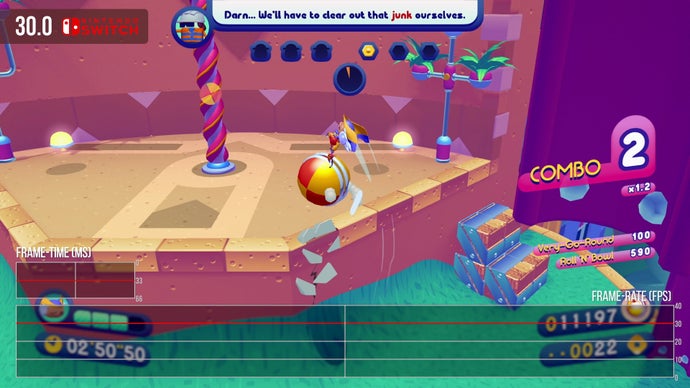
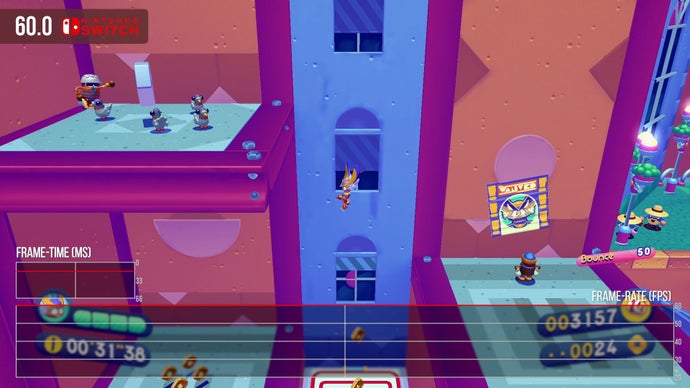
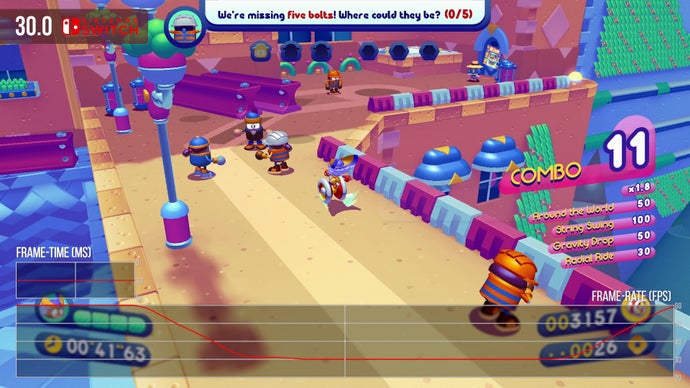
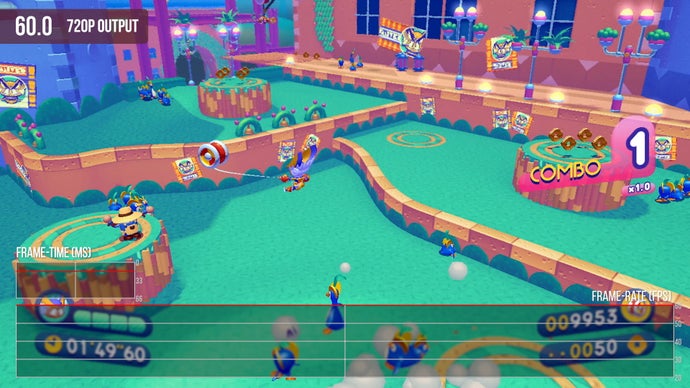
However, there’s a surprising solution to this that I’m not sure I can recall seeing on Switch until now. That is, the game responds to resolution changes at the system level. Set your Switch to 720p, for instance, and it directly modifies Penny’s render target size, resulting in 720p gameplay. This works even without closing the game and remarkably, it solves most of the performance issues. Areas which previously dropped frames suddenly spring to life without a hiccup perfectly sticking to 60fps.
I asked the team about this – Evening Star actually tried dynamic resolution scaling but it did not have the desired performance level versus simply altering the max resolution. Most of the game plays well at 1080p60, but if the performance dips do rankle, it transpires that there’s actually an undocumented ‘ultra performance’ mode. There’s only one more thing to note about the Switch version – the draw distance is pulled in. It’s something you probably won’t notice most of the time but when the camera looks out of certain scenes, you’ll spot the point where the scene is clipped.
While we’re discussing visuals, however, there’s one other element I feel deserves a mention – the camera system. We’re in the age of the right stick camera and, while this is generally OK for games today, I really enjoy a nice fixed camera system and that’s precisely what Penny’s offers. Basically, the camera follows Penny automatically as if attached to a dynamic rail system and it does a largely great job of framing the action. You get a perfect mix of cool looking angles with useful ones that frame the gameplay very effectively. Nailing jumps and judging depth largely works well though there are moments when it can be a little fiddly. I’m a big fan of the camera work here and feel that it’s a perfect fit for a platform game – especially since the right analogue stick is used for gameplay purposes.
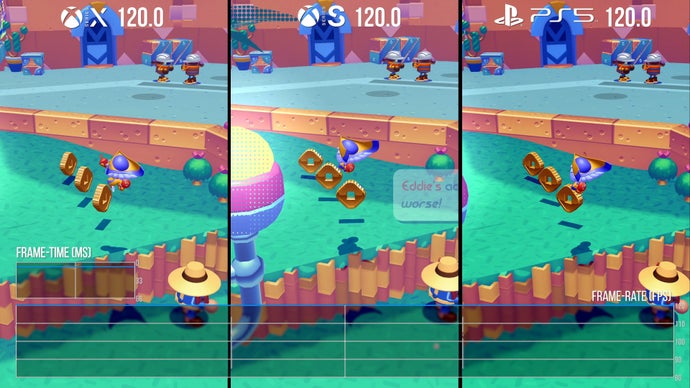
Audio also deserves mention. While it may not seem like a big deal, I feel that sound and music is just as important as the visuals while directly influencing your relationship with the gameplay. Music is very subjective, however, so this category is as well but, in the case of Penny’s, I feel that the music adds a lot to the experience. Firstly, Tee Lopes returns to work with the Evening Star folks after creating the brilliant Sonic Mania soundtrack, but Tee is not alone – he’s also joined by Sean Bialo, composer of the insanely catchy Donut Dodo. Even Christian Whitehead and Hunter Bridges from the main dev team took a stab at a few tracks and they did a great job too.
When you combine the music, the visual flourishes and the sharp gameplay, it all just gels into this cohesive whole that becomes increasingly more engaging as you improve your own skills. However, this is a challenging game to master and, as a result, it may not click for everyone. It’s the same with Sonic the Hedgehog: there are always people that love the series, such as me, while others just never got it. The same goes for games like Nights Into Dreams among others. When playing any of these games, including Penny’s, you can make your way through each level without taking full advantage of the move set but you may not have as much fun unless it clicks for you as it did me.
One of the coolest things about the game’s concept is how the team basically took the ring concept from Sonic and flipped it on its head. It has what I call a ‘reverse ring’ system. The main enemy types in this game are the Penguins that chase you around – you might be tempted to stop and attack them like a typical action game but you should not. Instead, avoid them. That’s because you lose a life and get sent back to a checkpoint if more than five penguins latch onto Penny. Sonic, in comparison, has you collecting rings to stay alive and if you take a hit with zero rings and you lose a life. The Penguins, then, are the ‘anti-ring’ – they are scattered around the levels and collecting them results in failure.
This then feeds into the momentum and combo systems – the game is at its best once you’ve figured out how to take advantage of the rolling terrain and keep on moving. You want to avoid enemies and keep your speed up – if you can pull off a combo while doing that, all the better. The key here is getting into the groove. The first time you play a stage you might bumble around but you can and should give every stage multiple tries and as you learn them, as you find that combo string, the game really comes alive.
Which is why it works so well for me. I love games that put you in a state where you just feel pure happiness. A specific blend of music, visuals and fluid gameplay that rewards a precise touch is exactly what I love best. In a way, this feels like the kind of experience you might have expected from Treasure, creators of Gunstar Heroes, Dynamite Headdy and the like. It has a crunchy exterior with a warm, wonderful centre that richly rewards those who reach it.
Perhaps I’m a little late to the party in singing Penny’s praises – but this is a genuinely superb, joyous release with an impeccable technical foundation. Months on from release, I’m still playing it. And there’s a demo, so why not give it a try?
